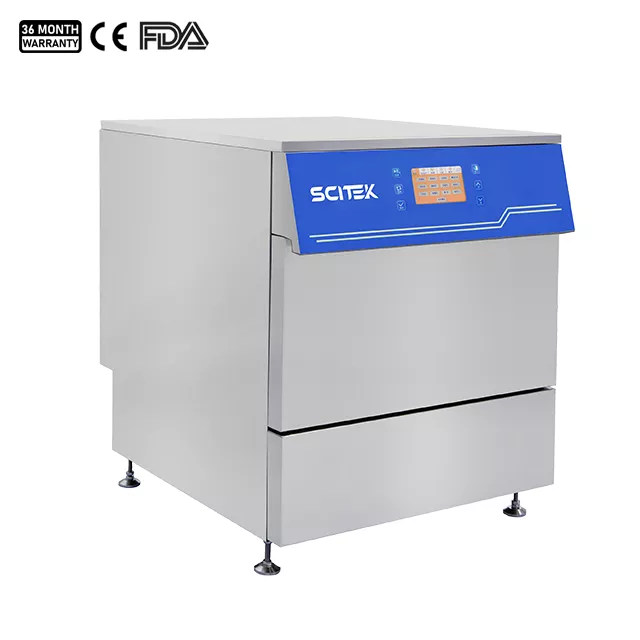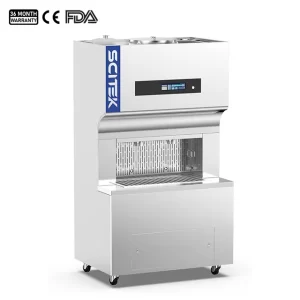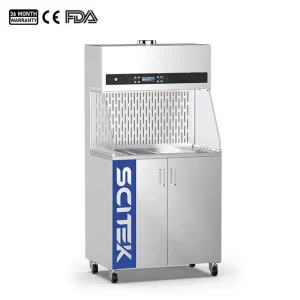Description
Well-designed compact capacity for small-scale laboratories and research sites ensures efficient and cost-effective cleaning solutions. Ideal for laboratories and research sites, this state-of-the-art unit combines efficient cleaning performance, reliable automation technology and a compact design to meet the unique needs of small-scale laboratories.
Laboratory glassware washer feature:
Humanized Operating System
- The man-machine interface features a 4.3-inch color LCD touchscreen, enabling intuitive touch operation within the visual field for convenient operation. It includes pressure sensing, making it well-suited for complex operating environments.
- The PLC programmable micro-computer operating system ensures stable and reliable performance. It is designed to be anti-magnetic and resistant to breakdowns.
Standardized Cleaning
- Dual Peristaltic Pumps:Disinfection effectiveness mainly depends on the correct performance of the washing phases and the neutralization of the treated material. Creatrust washers come equipped with two peristaltic pumps: one dedicated to dispensing the alkaline detergent during the cleaning phase and the other for dispensing the acid neutralizer during the neutralization phase.
- By controlling the cleaning process and monitoring key cleaning parameters through automatic program flow control, the automation and standardization of vessel cleaning can be achieved;
- Equipped with two water inlets controlled by electromagnetic valves, users have the option to select between tap water and purified water during the wash and rinse phases
- The 360° spray mechanism ensures comprehensive internal and external cleaning of the container, eliminating dead spots and ensuring optimal cleaning effectiveness.
- The pure water inlet features an integrated booster pump, enabling direct suction of purified water without the need for an external booster
- Consistency is maintained across different batches, as well as within each batch, ensuring the cleaning effect at every point remains uniform
- Enables traceability management of cleaning data for enhanced record-keeping and accountability.
Filter System
Equipped with dual stainless steel filters to safeguard the recirculation and drainage systems. These filters can be effortlessly removed for cleaning. Additional filters are installed on all incoming water lines and air intakes to ensure debris is pumped out effectively.
Automatic Glassware Washer Features:
- Efficiently removes organic residues and metal ions through automated high-temperature, high-pressure water cleaning.
- Efficient cleaning with a powerful imported pump, even water distribution, secure sealing, and rotating spray arms for thorough cleaning.
- Secure door lock with emergency opening, comprehensive protection with alarms, and English prompts for safe operation.
- Equipped with an imported double insulated ceramic liner, ensuring stable performance.
- The double-shell design incorporates an insulated air sleeve and double guiding air passage for enhanced thermal insulation.
- It utilizes a high-precision micro-computer controller and precision sensor, resulting in accurate temperature control.
Applications of Glassware Washer:
- Suitable for daily work in small laboratories, it provides researchers with a convenient and quick solution for glassware washing, ensuring clean and sterile vessels during experiments.
- In the medical field, especially in small-scale medical laboratories, the automatic glassware washer provides efficient and reliable cleaning and sterilization of medical vessels to meet the hygiene requirements of medical experiments.
- For laboratories conducting small-scale chemical experiments, the device ensures that glassware is optimally cleaned before testing, helping to improve the accuracy and reproducibility of experiments.
- In biotechnology laboratories, the automatic glassware washer effectively cleans petri dishes, tubular centrifuge tubes and other vessels to ensure that samples are not contaminated.
- The small capacity glassware washer plays a key role in food science research, ensuring that the vessels used in research and analysis meet high hygiene standards.






